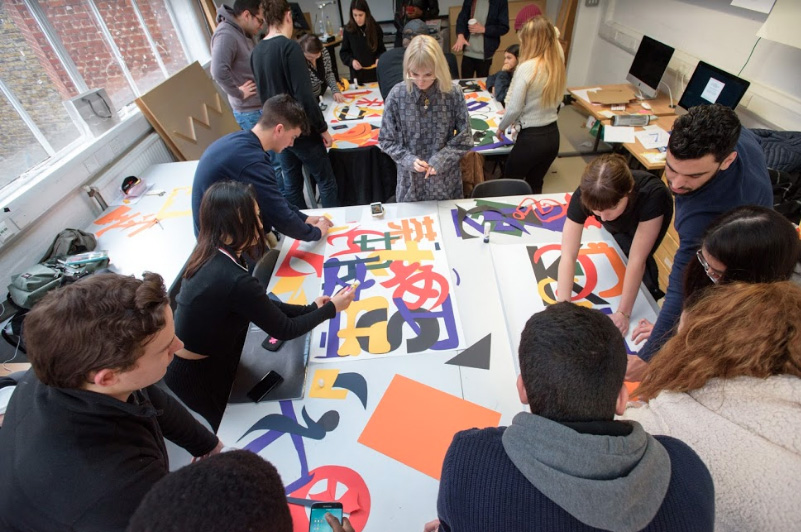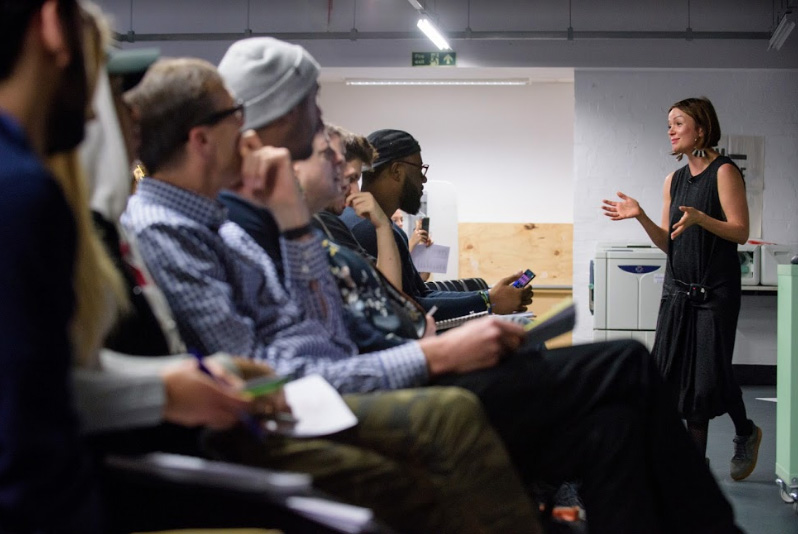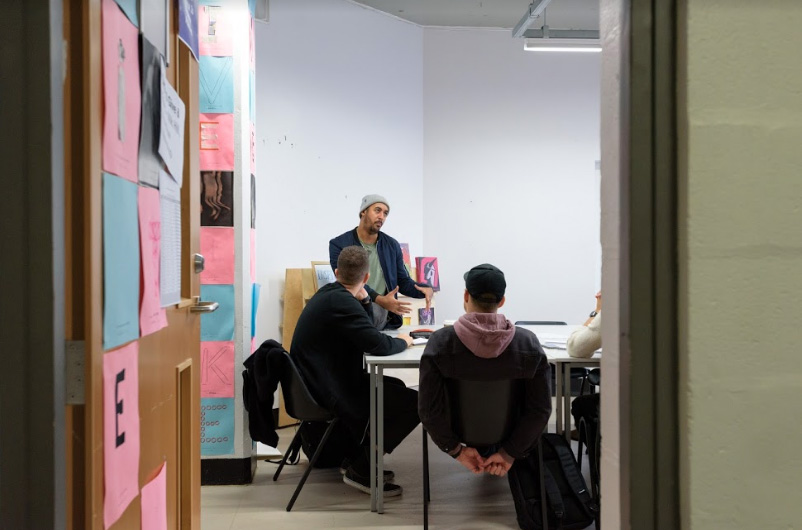 Making A Living Week, November 2018: Industry, Diversity And A New Topic of Conversation
Making A Living Week, November 2018: Industry, Diversity And A New Topic of Conversation
This blog post brought to us by Angharad Lewis, Lecturer in Visual Communication at The Cass: The Sir John Cass School of Art, Architecture and Design. All photographs taken by Steve Blunt.
The programming of events designed to connect our art and design students with practitioners and industry are thought to be a great way to support work-related-learning; but are they always effective, relevant and a turn-on for students?
To address this, we responded to student feedback and tweaked our format and made interaction between students and guests really dynamic, whilst also tackling issues of diversity and inclusivity.
Making A Living Week
I have had the pleasure of curating a day of activity for students as part of The Cass’s ‘Making A Living Week’ (MALW) for the last two academic years. The idea of this week of activities, across all Schools in the Cass, is to aid students’ transition from studenthood to employment and to introduce and develop skills and processes that kick-start their journey into industry.
Changing up the format
Based on student feedback from last year, and after discussion with colleagues, I made some changes to the format this year. In 2016/17 the Visual Communications (Vis Comm) day for MALW comprised three talks from industry experts*. Informal feedback from students following the event was that the talks were useful and engaging but that it was tiring to ‘be talked at’ for the whole day.
Less Pale and Male?
I was also conscious that the line-up of the 2017 event gave a platform to industry figures who all happened to be male and white. The speakers were inspiring, but I wanted to take positive steps to present industry figures who better reflect the students themselves – so that students see people on a stage (being held up as ‘expert’ or ‘successful’) to whom they can relate on a personal, cultural and social level. As a department, we want to offer credible role models that reflect the diversity of our student cohort. This means more women, more people of colour, more people from a working class background.
The Girlhood
The format of our 2018 event also included interactive elements. The students all began the day together with a talk by Kati Russell, founder of The Girlhood, an initiative whose goal is to “encourage a richer mix of women in the creative industries”.
Kati’s talk included practical exercises with pen and paper for the students to take part in. Her theme was empowering the students to make confident choices about their career path into professional working life, whatever their gender. Although Kati’s projects via The Girlhood are aimed at young women, it is important that students of all genders hear positive messages about diversity in the creative professions. As a School, we are increasingly conscious of the disparity between our richly diverse students, and the comparative paucity of diversity presented by the professional design industry.
 [image Katie Russell talk 2.png]
[image Katie Russell talk 2.png]
Hands-On Workshops
After Kati’s talk, we introduced four more guests from industry. Students broke into groups, and spent the rest of the morning participating in practical design workshops, run by our guests, in Vis Comm studio spaces. Workshops covered four hands-on areas: using paper creatively on a budget (led by Justin Hobson from Fenner Paper); typographic poster compositions (led by design studio Regular Practice); putting together a winning portfolio (led by creative portfolio consultant Fig Taylor); and mastering digital workflow (by creative director Nik Hill).
 [images: Workshop Regular Practice (top).png / Workshop Nik Hill (above).png]
[images: Workshop Regular Practice (top).png / Workshop Nik Hill (above).png]
The Keynote
In the afternoon, everyone reassembled for our keynote speaker, Kate Moross, a designer, illustrator and art director who spoke very engagingly, without notes, and with great honesty about her experience in the industry. I had invited Kate to speak because she is something of a maverick – she began doing commercial work for clients while she was a student and set up her own company soon after graduation. She has a clear ethos about the way she practices design and doesn’t follow the rules as defined by the dominant forces of the industry.
Preferred Pronoun?
In the week leading up to the event I had noticed an interesting thread on Kate’s Twitter feed, the subject was tips for people organising design panels, and not making assumptions about speakers’ gender identities:
“1. Don’t assume, it’s that simple.
- Ask people what pronoun they prefer.
- A pronoun is a pronoun not a gender identity, so you can ask that too….”.
The Tweets had kicked up quite a storm of debate. I knew that Kate was gay and I had recently read an article where she referred to herself as gender non-binary. I thought I had better ring Kate up and ask about her preferred pronoun. We had a good chat (I found out that ‘she/they’ pronouns are cool with Kate) and I realised that this is a new topic of conversation that is now relevant to my work as a teacher. Kate asked whether we have any queer or gender non-binary students and I was happy that I could say we do.
Sincere Stories
For her talk, Kate was enthused by our ‘Making A Living Week’ theme. She felt it was important to talk honestly to students to prepare them for the realities of work, in a way that is sometimes lacking in teaching on creative courses. Interestingly, Kate did not present any slides of her own work (other than as backdrop for her Q&A), eschewing the standard format of design talks. Instead, the visuals in her presentation were entirely typographic – prompts for stories about her experience or practical advice and facts. For the first half of her session, Kate talked in a refreshingly honest way about topics like how much to charge clients, the no-holds-barred do’s and don’ts of CV-writing, and how traits that got her dubbed ‘a swot’ at school came in handy when running her own business.
 [image Kate Moross keynote1.png]
[image Kate Moross keynote1.png]
Kate then spent almost an hour taking questions. I can honestly say that this was one of the most successful questions-and-answer sessions I have ever attended. Kate had asked us to provide question cards in advance to generate uninhibited debate. She took the time to answer every single question, never disparaging the topic (even “can I have an internship at your studio”) and giving each a thoughtful, honest answer.
The positive energy in the room was palpable and the students were buzzing at the end of a very busy day. As staff, we felt that Kate Moross in particular had struck a chord with students as a speaker: finding things out from people who you can relate to culturally – who feel on your level in some way, however successful they are – can be powerful. Like hearing something from a sibling, rather than a parent. The format of the day also felt productive, with students given several points in the day to be active, get involved in discussion and explore their own ideas and generate practical work.
A comment on a student’s blog felt like a positive endorsement.
“I found Kate Moross’s talk really inspiring, the way she spoke about industry and getting yourself out there made me feel less scared and more excited!”
Angharad Lewis bio
Angharad is a lecturer, writer and editor specialising in design and publishing. She is co-editor of Grafik.net, former editor of Grafik Magazine and has contributed to various magazines and books on the subject of graphic design, illustration, publishing and photography. She is author of several books, most recently So You Want to Publish A Magazine? (Laurence King 2016). Angharad is Lecturer in Visual Communication and Course Leader of BA Design for Publishing at The Cass School of Art, Architecture and Design.
